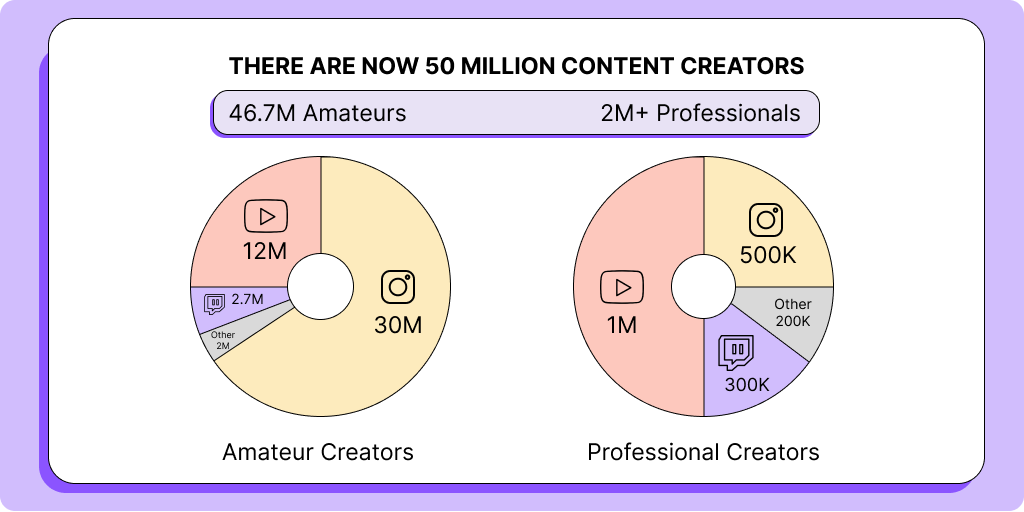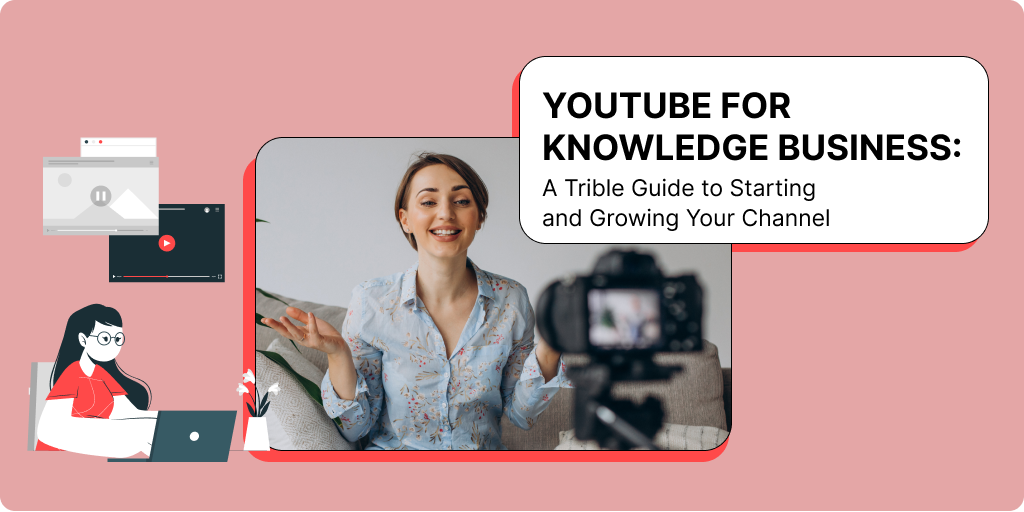What exactly is the creator economy? It is described as the class of enterprises formed by content creators, curators, and community builders, including social media influencers, bloggers, and videographers, as well as the software and financial tools aimed to assist them in growth and monetization.
The following are the three most important trends in the creator economy:
- Creators are shifting their top followers away from social media and onto their own websites, apps, and monetization tools.
- Creators are becoming entrepreneurs, forming teams and technologies to assist them in starting businesses while focusing on their work.
- As audiences desire to connect with unique individuals rather than impersonal publishers, creators are gaining influence in the media industry.
The creator economy, which emerged just a decade ago, now boasts over 50 million self-identified creators globally. It has rapidly become the fastest-growing small business sector, with a recent survey revealing that 29% of American children aspire to become YouTube stars, surpassing the 11% who wish to be astronauts. The rapid growth of creatorship can be attributed to a shift in societal consciousness towards finding fulfilment in our careers, having control over our time, and being our own bosses. Fans witness creators doing what they love for a living and aspire to follow in their footsteps rather than conforming to a traditional office environment.
The industry has reached an inflexion point, thanks to improved phone cameras, larger screens, faster mobile networks, and social media platforms designed for creators. To join the creator club, one only needs a smartphone, an idea, and a willingness to face the judgment of strangers. However, success is far from guaranteed, with only a few views and no brand deals. Creators must possess exceptional storytelling abilities, unrelenting drive, and the ability to lead their fan communities.
Fortunately, there is a plethora of companies dedicated to supporting creators, especially the 2 million individuals who have made it their full-time career. The total market of creators is estimated to be around 50 million individuals.

Professional Individual Creators (~2M+) – Making content full-time
- YouTube: Of the 31M channels on YouTube, ~1M creators have over 10K subscribers
- Instagram: Of the 1bn accounts on Instagram, ~500K have over 100k followers and are considered active influencers
- Twitch: Of the 3M streamers on Twitch, ~300K have either Partner or Affiliate status
- Others: including musicians, podcasters, writers, illustrators, etc, total ~200K
Amateur Individual Creators (~46.7M) – Monetizing content creation part-time
- YouTube: Of the 31M channels on YouTube, ~12M have between 100-10K subscribers
- Instagram: Of the 1bn accounts on Instagram, ~30M have between 50-100K followers
- Twitch: Of the 3M streamers on Twitch, ~2.7M are non Partner or Affiliates
- Others: including musicians, podcasters, writers, illustrators, maybe a total of ~2M
A Brief History Of The Creator Economy
Foundational Media Platforms
Since the late 2000s, platforms such as YouTube, Instagram, Spotify, iTunes, and others have emerged, with more recent additions like Snapchat, Twitter, Medium, Twitch, and TikTok. These platforms help creators establish an audience and gain visibility through recommendation and curation algorithms, which solve the problem of content distribution for creators.
Gone are the days when creators were subject to the whims of large production companies that dictated what content would be created and who the audience would be. These platforms have facilitated the emergence of multi-channel networks like Maker and Fullscreen that aggregate creators and equip them with audience development tools, as well as new networks like Brat TV and Tastemade.
The emergence of these platforms has also necessitated the development of multimedia editing tools that enable creators to polish their content. However, platforms may not always have the best interests of content contributors in mind. Therefore, smart creators learn to cross-promote and diversify their presence across different apps to reduce platform risk.
COVID-19 has had a significant impact on the industry, as consumer engagement in entertainment has increased, leading to more time spent on these apps, more consumption of content, and increased revenue for creators. This, in turn, can fuel the growth of platforms while making creators more willing to pay for tools that help them. Investment opportunities in this space are promising, as innovative tools that are adopted by creators can quickly go viral on social media. However, Adobe is a major incumbent in this space with clear network effects, as its file types have become the industry standard for sharing among creators. Monetizing point solutions for creators is also challenging unless there is a clear ROI or the product is highly differentiated and defensible.
Monetizing Influencer Reach
As top creators built their audience and established trust with their followers, brands began to recognize the value of paying creators to promote their products and services to their on-platform reach. Some platforms shared ad revenue with creators, while others left it up to the content makers to monetize, leading to the emergence of sponsored content and companies like Niche that facilitate deals.
The influencer marketing TAM is currently around $8 billion and is projected to reach $15 billion by 2022, making it one of the fastest-growing businesses. It’s important for creators to work with sponsors that align with their personal brand and maintain content quality without sacrificing authenticity. However, as influencer marketing became more widespread, creators noticed that each paid post chipped away at the trust they had built with their audience, leading to a decline in engagement and growth. This trend brings us to the latest evolution of creators.
Influencer Marketing
Specialized Influencer Marketing Agencies
In order to reach specific audience demographics, brands enlist the help of influencer agencies. These agencies are responsible for identifying high-performing influencers, negotiating contracts, maintaining communication, launching cross-channel campaigns, and conducting post-campaign analysis and ROI assessments. The biggest influencer agencies are Mediakix, Pulse Advertising, WHOSAY, and Everywhere.
Since brands may not have direct connections to influencer talent or in-house teams to work with them, they rely on these agencies. However, due to their personalized and hands-on approach, these agencies can be costly for both brands and influencers. Public relations firms like Edelman and Weber Shandwick have also gotten involved as intermediaries between creators and brands while also protecting their clients’ reputations.
Influencer Marketing Platforms and Marketplaces

Influencer marketing platforms offer a cost-effective solution for brands to access a wide range of influencers but typically only have access to small-to-medium-sized influencers. These platforms charge a Software-As-A-Service fee plus a take rate on each campaign but don’t provide access to larger influencers that typically work with agencies.
Brands can search for influencers on platforms such as Grin, Captiv8, and AspireIQ and set a budget for their campaigns. Hollywood talent agencies such as CAA, UTA, and WME partner with influencer marketing giants to make their mainstream celebrities available to brands. Other platforms, such as The Plug, allow influencers to choose which campaigns they want to work with and only charge advertisers on a performance basis. Brands can also use platforms like Pixlee to automatically find and curate user-generated content on social media, which can be more cost-effective and authentic.
Companies such as Collectively and theAmplify, Delmondo, and Whalar offer quantified influencer marketing and analytics services. Fans and brands can find influencers on Famous Birthdays, which ranks influencers based on their popularity. Influencers may sell creative services for producing content, distribute existing content to their audience, or do both.
CRM Tools
Influencers often work with multiple influencer marketing platforms and have several brand contracts simultaneously, which has led to the development of CRM tools such as Tubular Labs, MoeAssist, and CloutJam, specifically for influencers to manage their workflow. Regarding the impact of COVID, there have been minor tailwinds in the influencer marketing space. Due to the inability to conduct in-person professional shoots, brands have turned to creators for user-generated content. However, other brands have mostly halted their marketing efforts to conserve cash.
In terms of investment opportunities, there is potential to create a large, scalable business in the platform/marketplace segment, as brand marketing remains the primary source of income for creators. The question remains as to who will become the DoubleClick of influencer marketing. However, there have been no major outcomes in this space, with Twitter’s acquisition of Niche and Google’s acquisition of FameBit only amounting to tens of millions.
Creators as businesses
This is where we are now! Creators have amassed followings that extend beyond social media platforms, allowing them to operate as full-fledged businesses with numerous sources of revenue in addition to ads. Companies have emerged to assist creators in making money by selling products such as merchandise, premium content, books/eBooks, and newsletters or providing services such as fan engagement, coaching, consulting, speaking engagements, and more. This enables creators to concentrate on satisfying their biggest fans and producing niche content rather than striving for the largest possible audience and generating more generic, clickbait content.
The key trend we see here is that creators are increasingly diversifying their revenue streams and receiving direct support from their fans. Creators have evolved from being compensated by platforms like YouTube through ad revenue shares for drawing in an audience to the platforms to being paid by brand sponsors on Instagram and Snapchat for their outreach and to being compensated by fans via patronage, tipping, or eCommerce for entertainment and community beyond the platforms.
With the long tail of amateur influencers reaching 50 million and growing rapidly, there is a lot more competition for brand deals among influencers, which drives them to explore other ways of earning income.
Subscription-Based Funding
The idea of supporting your favourite creator through a monthly subscription was pioneered by Jack Conte and his company Patreon. Initially, the idea was created to provide consistent financial support for his band Pomplamoose and their music video production studio. Recently, media platforms like Twitch and Youtube Channel Membership have started developing their infrastructure to allow creators to charge subscription fees directly on their channels. However, cross-promoting other content creators to a creator’s fanbase can cause irritation and lead to subscriber churn.
An alternative to the recurring donation model is the “tip jar” concept, which allows fans to make one-time donations. Platforms like Ko-fi and Buy Me a Coffee offer creators the ability to request $5 donations periodically without the need for upfront payment, maximizing their audience reach while still providing a way for fans to support the creator financially. Larger social networks also offer tipping options, especially during live streams, in exchange for shout-outs from the creator or special badges and visibility to other fans.
This “economy of recognition” allows creators to focus on creating niche content tailored to their biggest fans and benefits platforms by attracting creators without much effort. The COVID-19 pandemic has had a net-neutral impact on this trend, with an increase in supply due to people turning to create content for additional income streams. Despite financially stable patrons being more generous, the rise in unemployment has led to a decrease in demand, with many people cutting discretionary spending, including monthly donations to creators.
Evaluation of Investment Opportunity
- Advantages: Platforms such as Twitch or YouTube, which have integrated systems, can charge a high commission of 30-50% due to their ability to use their existing consumer engagement to provide creators with significant value in audience-building.
- Disadvantages: Conversely, independent companies typically have a low commission rate of around 5% as they lack additional value and need to collaborate with creators. Given that the leading platforms in this field have fewer than 500K creators, it would be challenging to develop a significant business with a 5% commission on average monthly donations of $10.
What else can creators sell?

Interactions with fans
These are platforms that offer creators the ability to monetize various forms of interaction with their fans. Cameo garnered attention in this field by establishing a marketplace where fans could pay for personalized video shout-outs from celebrities, which made it easy for creators to earn $50-100 for creating a brief 30-second video, thus rapidly expanding their supply side. Starsona follows a slightly different approach by enabling creators to sell a wide range of interactions with fans, such as direct one-on-one messaging, Q&A, creating a playlist for parties, reviewing photographs, creating ringtones, and more.
Meanwhile, Camelot permits YouTube and Twitch audiences to pay for the content they want to see, such as fans requesting streamers to “win with no armor,” “add a heartbeat monitor to the stream,” or “play a cover of Hey Jude.”
Online Courses and Webinars
Online course builders like Trible, Kajabi, Teachable, Thinkific, and Podia provide creators with a comprehensive suite of tools that enable them to market, engage, and monetize their courses. Other companies, such as Monthly, offer their own curated courses led by creators.
Meanwhile, platforms like Lu.ma, Airsubs, Stream.club, Via.live, Reach.live, and Mixly allow creators to sell access to webinars via video chat platforms like Zoom. These are particularly popular among creators with specialized skills, such as watercolour painting, cake making, or producing electronic music. These creators often amass a large following on social media platforms by sharing glimpses of their expertise in impromptu videos, and then directing the most engaged learners to their dedicated online course pages.
Newsletters and eBooks
Substack provides a platform for writers to monetize their newsletters by building independent audiences and setting subscription fees. With Substack, top writers like Luke O’Neil can make $50-100k per year by acquiring just 400 subscribers paying $10/month or 800 subscribers paying $5/month. O’Neil’s popular newsletter Hell World, which reports on the distressing realities of American life in a unique stream-of-consciousness style, is one such success story.
Meanwhile, the largest players in the merchandise-selling space are Fanjoy and Teespring, which enable creators to sell apparel and integrate with YouTube, Instagram, and Twitch. Other options include DFTBA, Represent, and CrowdMade. However, merchandise sales may not be a reliable source of income for creators, as super-fans may purchase items infrequently.
In the COVID pandemic, more creators are turning to these platforms to supplement their income, creating tailwinds for the creator economy. As such, companies that help creators generate additional income have a strong potential for success in this space. However, each business model will require careful examination on a case-by-case basis, as some models, such as selling merchandise, have become commoditized and operationally intensive, making scaling difficult.
Creators are the new founders
We are currently at a turning point in history where becoming a professional creator is one of the most sought-after careers. Creators are driven by their passion for creating, but as they grow their audience and income, the administrative responsibilities of their business become increasingly burdensome. The startups that will dominate the next phase of this evolution are those that empower creators to monetize their work seamlessly while remaining focused on creating content.
Becoming a successful creator today requires moving beyond being an artist to becoming a founder. This job now involves product management, design, community engagement, eCommerce, and data science, in addition to entertainment. Creators need to assemble a team of experts and vendors to help manage the tools required to build a diversified business across various platforms. However, this diversification also provides resilience. Creators become less vulnerable to changes in the priorities of tech giants or their algorithms by owning a direct relationship with their fans. Each creator can create a unique balance of revenue streams that match their style, no matter how niche.
This is a significant victory for all, as creators who cater to our unique interests can now establish a viable careers. Rather than having only mainstream, generic content, we have content that is tailored to every subculture. There are now enough creators to support an entire startup ecosystem that can assist them in turning their passion into their profession.
 Open Sesame: 225 Engaging Email Subject Lines + Crafting Tips
Open Sesame: 225 Engaging Email Subject Lines + Crafting Tips







